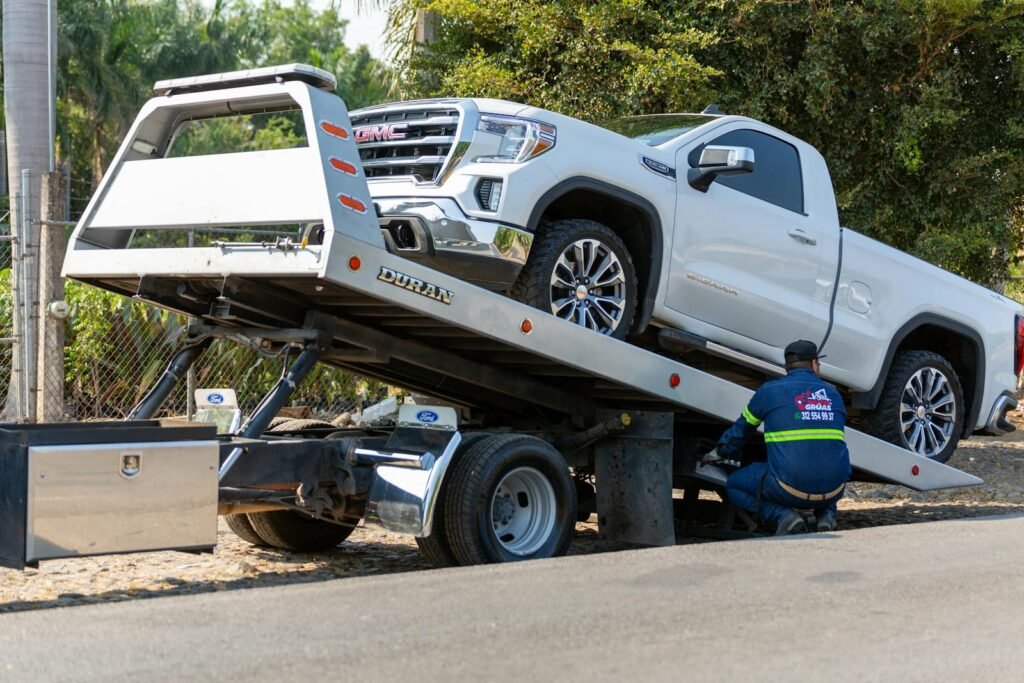Whether you find yourself facing a car breakdown on a desolate road or need to transport a vehicle across city or state lines, knowing how to tow a vehicle safely is an invaluable skill. When done correctly, towing ensures not only the protection of your vehicle but also the safety of other road users. Towing, however, is not just about hooking up a car to a truck—it requires understanding towing equipment, following safety guidelines, and adhering to legal regulations.
In this detailed step-by-step guide, we’ll cover everything you need to know about safely towing a vehicle, including tips on choosing the right truck, handling legalities, preparing your car, and making your towing experience as smooth as possible.
1. Importance of Safe Vehicle Towing
When it comes to towing a car with a truck, safety should always be the top priority. Unsafe towing can lead to severe damage to the vehicle, accidents on the road, and potential legal repercussions. Here’s why towing safety matters:
- Prevents vehicle damage: Improper towing can damage parts like the transmission or suspension, leading to costly repairs.
- Reduces accident risks: Safe towing practices prevent accidents that may endanger you, your passengers, and other road users.
- Legal compliance: Many states have specific towing regulations, such as requirements for tow lights or safety chains. Following these ensures that you’re compliant with the law.
- Preserves towing vehicle condition: Correct techniques reduce wear on the truck, making it a safer, more effective process.
By understanding the nuances of safe towing, you’ll be ready to transport your car safely, whether for short distances or extended trips.
2. Understanding Towing Legalities
Legal regulations surrounding vehicle towing can vary significantly by state. Some states prohibit towing a vehicle with another vehicle unless it’s for emergency purposes. Before setting out, familiarize yourself with these legalities to avoid fines or other penalties.
- State-specific regulations: Different states have different requirements for tow bars, lights, and permissible distances.
- Safety inspections: Most states mandate the use of safety chains, lights, or other reflective items to alert other drivers.
- Towing a car with another car: This may not be allowed in all jurisdictions, especially for non-emergency situations.
Researching state laws and abiding by these guidelines ensures not only your safety but also legal compliance on the road.
3. Essential Towing Equipment
Equipping yourself with the right towing equipment is key to a smooth towing experience. Here’s a list of basic equipment you’ll need:
- Tow straps or chains: Designed to handle the towed vehicle’s weight, these are essential for secure towing.
- Safety lights and reflectors: Reflective triangles, cones, or flashing lights improve visibility, especially at night.
- Tow hitch and safety chains: The right tow hitch ensures compatibility with your truck, while safety chains provide an added layer of security.
Quick Tip: Regularly inspect your equipment to ensure it is in top shape, reducing risks associated with wear and tear.
4. Selecting the Right Truck and Tow Hitch
Not all trucks are built the same when it comes to towing. Choosing the right truck and tow hitch is crucial for a safe experience:
| Hitch Type | Weight Rating (lbs) | Suitable For |
|---|---|---|
| Class I | 2,000 | Lightweight vehicles |
| Class II | 3,500 | Medium-sized cars |
| Class III | 8,000 | Large vehicles and small trucks |
| Class IV | 10,000 | Heavy-duty towing |
Check the towing capacity of your truck, as overloading can lead to serious mechanical issues, including brake failure and tire wear. Popular choices for towing include the Ford F-150, Chevrolet Silverado, and RAM 1500, as these trucks are designed with substantial towing capabilities.
5. Preparing Your Car for Towing
Preparing your vehicle for towing is especially important if it has an automatic transmission. Follow these steps to protect the transmission and prevent any additional damage:
- Consult the owner’s manual: Many manufacturers provide specific towing instructions.
- Place the vehicle in Neutral: This minimizes wear on the transmission.
- Use a tow dolly for automatic cars: Lifting the drive wheels helps prevent transmission damage.
- Check all fluid levels and tire pressure: Ensuring the vehicle is in good working order reduces towing risks.
- Attach all safety equipment securely.
When done properly, these steps safeguard your vehicle, making the towing process smoother and safer.
6. Executing a Safe Tow Step-by-Step
How to tow a vehicle safely involves more than just hooking up your car. Follow this step-by-step guide for a successful tow:
- Secure the Tow Hitch: Attach it to the truck’s towing location, ensuring a firm lock.
- Connect Safety Chains: Cross them under the trailer hitch to add stability if the main hitch fails.
- Attach Tow Bar or Tow Dolly: Align and fasten tightly to both the truck and towed vehicle.
- Inspect Wheel Bindings and Lights: Check that the towed vehicle’s wheels are secure and all lights work properly.
- Begin Driving Slowly and Cautiously: Avoid sudden braking or sharp turns to prevent loss of control.
Pro Tip: Perform a final check of all connections before hitting the road to ensure nothing has shifted or come loose.
7. Comparing Towing Methods: Flat Towing vs. Using a Tow Dolly
There are several towing methods, each with its own pros and cons. Here’s a comparison:
| Method | Benefits | Drawbacks |
|---|---|---|
| Flat Towing | Quick setup, no additional equipment needed | Not suitable for all automatic vehicles |
| Tow Dolly | Protects transmission for front-wheel drive | More cumbersome to transport and set up |
| Tow Bar | Ideal for long-distance and stability | Requires alignment with vehicle’s frame |
Depending on your vehicle type and distance, you may prefer one method over another for greater efficiency and safety.
8. Alternatives to a Tow Dolly
Tow dollies aren’t always necessary, especially for shorter distances. Here are some tow dolly alternatives:
- Tow Bars: Attach directly to the car’s frame for a stable, secure connection.
- Towing Cradles: These lift the car’s front wheels, ideal for front-wheel-drive vehicles.
Alternative methods offer flexibility based on your specific needs and equipment availability.
9. Towing Long Distances
When towing over long distances, preparation is critical:
- Inspect truck and towed vehicle thoroughly for issues.
- Route planning helps anticipate stops for refueling and resting.
- Regular breaks prevent fatigue and allow for checking the connections.
Long-distance towing requires extra caution and proper route planning to ensure safety and minimize risks.
10. Avoiding Common Towing Mistakes
Even experienced drivers make common towing mistakes. Here’s what to avoid:
- Overloading the Truck: Always check the tow capacity to prevent strain on the truck.
- Skipping Regular Inspections: Frequent checks help catch loose connections or wear on towing equipment.
- Ignoring Tow Weight Limits: Going beyond the rated capacity risks mechanical failure, especially on steep inclines.
Being aware of these mistakes and avoiding them can help make your towing experience safer and more efficient.
Conclusion
How to tow a vehicle safely is about following specific steps and staying vigilant throughout the towing process. By understanding the legal requirements, choosing the right truck and equipment, and using the proper technique, you can confidently tow any vehicle.
FAQ
1. How to Tow a Car with a Truck?
Start by securing the tow hitch and attaching safety chains, then proceed to connect the tow bar or tow dolly, checking all connections before hitting the road.
2. How to Tow Without a Tow Dolly?
Use tow bars or cradles to keep the vehicle stable. Ensure all connections are tight and wheels are properly bound.
3. How to Tow a Car Long Distance?
Inspect the setup and plan for regular breaks to check all connections. Drive cautiously and monitor the weather for optimal safety.
4. What Are the Best Trucks for Towing?
Vehicles like the Ford F-150, Chevrolet Silverado, and RAM 1500 are highly rated for towing due to their power and reliability.
5. What Equipment Is Essential for Towing?
Tow straps, hitches, safety chains, and reflective lights are must-haves to ensure secure and legal towing.

